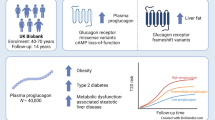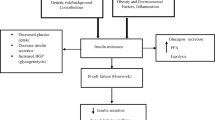Abstract
A high but normal fasting plasma glucose level in adults is a marker for insulin resistance and future development of type 2 diabetes mellitus. We aimed to investigate whether ADIPOR2 variants are associated with increased fasting plasma glucose (FPG) in non-diabetic Chinese Han subjects who had normal FPG levels. This study included 2038 subjects among the non-diabetic Chinese Han population. The ADIPOR2 polymorphisms were genotyped by the TaqMan method. For the analysis, participants were divided into low-normal FPG group (FPG < 4.88 mmol/L) and high-normal FPG group (6.1 mmol/L > FPG ≥ 4.88 mmol/L). We identified five single nucleotide polymorphisms (SNPs) of ADIPOR2 gene: rs10773989, rs2370055, rs9300298, rs10773983, and rs13611594. There was no significant difference in FPG levels between different genotypes of rs10773989, rs2370055, rs9300298, and rs13611594. Our data showed a significant association of rs10773983 with higher FPG levels, fasting insulin levels, and homeostatic model assessment of insulin resistance (HOMA-IR) in A-allele carriers (p = 0.006, p < 0.001, and p < 0.001, respectively). The subjects in high FPG group had higher median fasting insulin level (9.25 vs 8.16 μIU/mL, p = 0.003) and higher HOMA-IR (2.21 vs 1.58, p < 0.001) than those in normal FPG group. Subjects with the A-allele of rs10773983 compared to subjects with G-allele had 1.222-fold higher risk for high-normal FPG (OR = 1.222, 95%CI = 1.010–1.478, p = 0.039). Our findings suggest that ADIPOR2 rs10773983 polymorphism may be associated with an increased risk of high-normal FPG among non-diabetic Chinese Han subjects who have normal FPG levels.
Similar content being viewed by others
References
Li R, Lu W, Jiang QW, Li YY, Zhao GM, Shi L, et al. Increasing prevalence of type 2 diabetes in Chinese adults in Shanghai. Diabetes Care. 2012;35(5):1028–30.
Dagogo-Jack S, Askari H, Tykodi G. Glucoregulatory physiology in subjects with low-normal, high-normal, or impaired fasting glucose. J Clin Endocrinol Metab. 2009;94(6):2031–6.
Abdul-Ghani MA, Lyssenko V, Tuomi T, DeFronzo RA, Groop L. Fasting vs postload plasma glucose concentration and the risk for future type 2 diabetes: results from the Botnia study. Diabetes Care. 2009;32(2):281–6.
Yamauchi T, Kamon J, Minokoshi Y, Ito Y, Waki H, Uchida S, et al. Adiponectin stimulates glucose utilization and fatty-acid oxidation by activating AMP-activated protein kinase. Nat Med. 2002;8:1288–95.
Weyer C, Funahashi T, Tanaka S, Hotta K, Matsuzawa Y, Pratley RE, et al. Hypoadiponectinemia in obesity and type 2 diabetes: close association with insulin resistance and hyperinsulinemia. J Clin Endocrinol Metab. 2001;86(5):1930–5.
Yamauchi T, Nio Y, Maki T, Kobayashi M, Takazawa T, Iwabu M, et al. Targeted disruption of AdipoR1 and AdipoR2 causes abrogation of adiponectin binding and metabolic actions. Nat Med. 2007;13(3):332–9.
Civitarese AE, Jenkinson CP, Richardson D, Bajaj M, Cusi K, Kashyap S, et al. Adiponectin receptors gene expression and insulin sensitivity in non-diabetic Mexican Americans with or without a family history of type 2 diabetes. Diabetologia. 2004;47(5):816–20.
Rasmussen-Torvik LJ, Pankow JS, Jacobs DR Jr, Steinberger J, Moran A, Sinaiko AR. The association of SNPs in ADIPOQ, ADIPOR1, and ADIPOR2 with insulin sensitivity in a cohort of adolescents and their parents. Hum Genet. 2009;125(1):21–8.
Ferguson JF, Phillips CM, Tierney AC, Pérez-Martínez P, Defoort C, Helal O, et al. Gene-nutrient interactions in the metabolic syndrome: single nucleotide polymorphisms in DIPORQ and ADIPOR1 interact with plasma saturated fatty acids to modulate insulin resistance. Am J Clin Nutr. 2010;91(3):794–801.
Stefan N, Machicao F, Staiger H, Machann J, Schick F, Tschritter O, et al. Polymorphisms in the gene encoding adiponectin receptor 1 are associated with insulin resistance and high liver fat. Diabetologia. 2005;48(11):2282–91.
World Health Organization. Definition and diagnosis of diabetes mellitus and intermediate hyperglycaemia.http://www.who.int/diabetes/publications/Definition%20and%20diagnosis%20of%20diabetes_new.pdf
The International Expert Committee. International Expert Committee report on the role of the A1C assay in the diagnosis of diabetes. Diabetes Care. 2009;32:1327–34.
WHO . Definition and diagnosis of diabetes mellitus and intermediate hyperglycemia. Geneva: World Health Organization; 2006. pp. 1–46. Report of a WHO/IDF Consultation Available at http://www.who.int.
Tirosh A, Shai I, Tekes-Manova D, Israeli E, Pereg D, Shochat T, et al. Normal fasting plasma glucose levels and type 2 diabetes in young men. N Engl J Med. 2005;353:1454–62.
O’Malley G, Santoro N, Northrup V, D'Adamo E, Shaw M, Eldrich S, et al. High normal fasting glucose level in obese youth: a marker for insulin resistance and beta cell dysregulation. Diabetologia. 2010;53(6):1199–209.
Shaye K, Amir T, Shlomo S, Yechezkel S. Fasting glucose levels within the high normal range predict cardiovascular outcome. Am Heart J. 2012;164(1):111–6.
Raizes M, Elkana O, Franko M, Ravona Springer R, Segev S, Beeri MS. Higher fasting plasma glucose levels, within the normal range, are associated with decreased processing speed in high functioning young elderly. J Alzheimers Dis. 2015;49(3):589–92. https://doi.org/10.3233/JAD-150433.
Cherbuin N, Sachdev P, Anstey KJ. Higher normal fasting plasma glucose is associated with hippocampal atrophy: the PATH study. Neurology. 2012;79(10):1019–26.
Yamauchi T, Kadowaki T. Physiological and pathophysiological roles of adiponectin and adiponectin receptors in the integrated regulation of metabolic and cardiovascular diseases. Int J Obes. 2008;32(Suppl 7):S13–8.
Yamauchi T, Nio Y, Maki T, Kobayashi M, Takazawa T, Iwabu M, et al. Targeted disruption of AdipoR1 and AdipoR2 causes abrogation of adiponectin binding and metabolic actions. Nat Med. 2007;13(3):332–9.
Bermúdez VJ, Rojas E, Toledo A, Rodríguez-Molina D, Vega K, Suárez L, et al. Single-nucleotide polymorphisms in adiponectin, AdipoR1, and AdipoR2 genes: insulin resistance and type 2 diabetes mellitus candidate genes. Am J Ther. 2013;20(4):414–21.
Funding
This study was funded by Beijing Municipal Administration of Hospitals’ Ascent Plan (grant number DFL20150701).
Author information
Authors and Affiliations
Corresponding author
Ethics declarations
The study protocol was approved by the Beijing Shijitan Hospital Ethics Committee, Capital Medical University. Written informed consent was obtained from all the participants before their enrolment in the study.
Conflict of interest
The authors declare that they have no conflict of interest.
Ethical approval
All procedures performed in studies involving human participants were in accordance with the ethical standards of the institutional and/or national research committee and with the 1964 Helsinki declaration and its later amendments or comparable ethical standards.
Rights and permissions
About this article
Cite this article
Liu, N., Yang, G., Hu, M. et al. ADIPOR2 variant is associated with higher fasting glucose level in non-diabetic Chinese Han population. Int J Diabetes Dev Ctries 38, 403–408 (2018). https://doi.org/10.1007/s13410-018-0620-7
Received:
Accepted:
Published:
Issue Date:
DOI: https://doi.org/10.1007/s13410-018-0620-7




